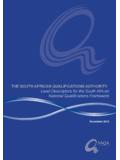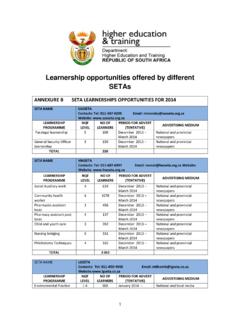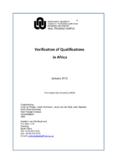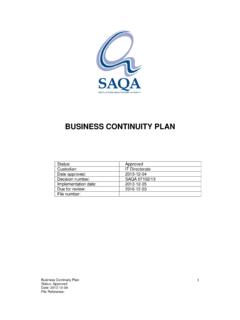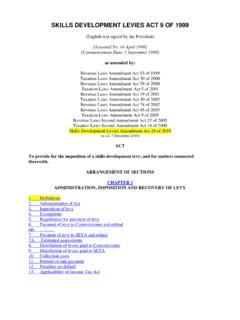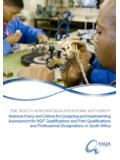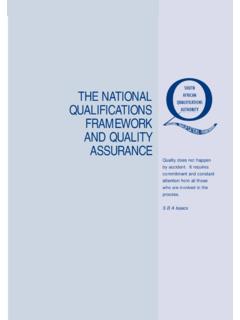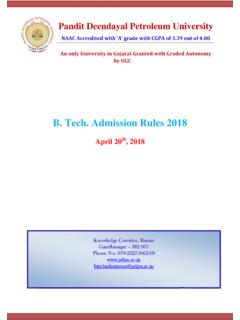Transcription of Frequently Asked Questions on the Higher …
1 1 Frequently Asked Questions on the Higher education Qualifications framework ( heqf ) joint FAQs by DoE, SAQA and CHE The Higher education Qualifications framework ( heqf ) was published on 5 October 2007 by the Minister of education (Government Gazette, Volume 508, No 30353). As an initial communiqu preceding the announcement of transitional arrangements by the Minister of education , the DoE, SAQA and the CHE/HEQC have put together FAQs on the heqf to enable institutions to initiate discussion and planning towards heqf -alignment of your institution s qualifications. Detailed guidelines from all the relevant regulatory bodies will be made available in 2008. 2Q: What is the aim of the heqf ? A: The heqf aims to determine the qualification types, characteristics and purposes of all Higher education qualifications in South Africa.
2 Q: How does the heqf relate to the NQF? A: The heqf is an integral part of the NQF. The heqf defines how Higher education qualifications fit within the NQF and also allocates the responsibility for standards generation and setting for Higher education qualifications to the Council on Higher : When is the implementation date of the heqf ?A: The implementation date of the heqf is 1 January 2009. The policy applies to both private and public institutions. It is the minimum admission requirements for entry into new programmes as set out in the Gazette Notice Number 27961 of August 2005 which will take effect. Transitional arrangements will be made for existing programmes. Q: What should institutions do between now and the 1 January 2009 with regard to their existing programmes and qualifications?
3 A: New programmes and qualifications to be offered in 2009 should be aligned as closely as possible with the heqf . Timelines for the re-structuring of existing programmes will be provided by the DoE, CHE and SAQA by 31st July 2008. Details of the implementation of the heqf will be made available to ensure that institutions have sufficient time to make transitional arrangements in relation to existing programmes. Q: How will the heqf influence the planning and development of new programmes?A: New Higher education qualifications that are submitted for registration on the NQF and accreditation by the HEQC must conform to the requirements of the heqf from the date of implementation, 1 January 2009. The rule will be applicable for PQM approvals for public institutions and registration of qualifications by the DoE for private providers.
4 New programmes scheduled to begin in 2009 should broadly meet the requirements of the heqf . Conditions may be set that will have to be complied with by 2009. 3Q: Must existing programmes and qualifications be aligned to the heqf by 1 January 2009? A: There will be a transitional period to ensure full compliance with the heqf policy. The Minister of education will determine the date of full compliance by notice in the Government Gazette. Details of transitional arrangements will be made available to institutions in the course of 2008. Q: Are the minimum admission requirements for a Higher education qualification going to change? A: The decision to admit students to Higher education studies is the responsibility of Higher education institutions.
5 Admissions policies must be consistent with the Higher education Act, 101 of 1997 and the NQF. The minimum admission requirement to new programmes from 1 January 2009 is the National Senior Certificate as published in the Government Gazette, Volume 481, No 27819, July minimum admission requirements for Higher Certificate, Diploma and Bachelor s Degree Programmes requiring a National Senior Certificate (Government Gazette, Volume 482, No 27961, August 2005 must be used for admission. The date for full compliance with the heqf will be determined by the Minister by notice in the Government Gazette. Q: How does the heqf affect the work of Professional Bodies? A: Professional Bodies will continue to determine whether a particular qualification offered by a particular Higher education institution meets the requirements for registration, membership or licensing of graduates.)
6 Professional bodies will continue to work in co-operation with the HEQC and other ETQAs. Qualifications must still comply with the qualification -type requirements of the heqf . Q: How does the DoE plan to engage with statutory and/or Professional Bodies around the heqf and its implementation in terms of processes and date of implementation? A: The DoE has initiated work with the CHE and SAQA on the implementation of the heqf . It will also talk to HESA. The purpose of the meetings will be to address all aspects of implementation and the implications of compliance by institutions. The DoE will address as many role-players on the heqf as possible, through various forms of media. 4Q: What are the new responsibilities allocated to the different regulatory bodies in terms of the heqf ?
7 A: The Ministry of education has overall responsibility for norms and standards for Higher education , including the qualifications structure for the Higher education system. The heqf recognises the role of the South African Qualifications Authority (SAQA) to be that of registering standards and qualifications in terms of the SAQA Act, 1995 (Act No 58 of 1995).The Higher education Quality Committee (HEQC) of the Council on Higher education (CHE) has the responsibility for quality assurance in Higher education in terms of the Higher education Act, 1997 (Act No 101 of 1997).The CHE is assigned the responsibility for the generation and setting of standards for all Higher education qualifications and for ensuring that such qualifications meet SAQA s criteria for registration on the NQF.
8 This responsibility is in terms of the heqf , No 508, No 30353 October : How is the number of credits needed for a qualification calculated? A: Credits are the measurement of the volume of learning required for a specific qualification . Credits are based on the number of hours of study. Ten notional study hours equal one credit. See pages 8-9 of the heqf . Q: What is the motivation behind the maximum of 96 credits on Level 5 of a Bachelor s Degree? A: This is to increase the cognitive demand of Bachelor s Degrees in line with the growing need for more skilled : Does it mean that there should be some Level 6 modules in the first year already or is the idea that a student should only do 96 credits in the first year? A: Yes, the distribution of academic credits across the academic years should be appropriate for the : How should the first year of a Bachelor s Degree be arranged?
9 A: The programmatic arrangement is the responsibility of the institution subject to the accreditation by the HEQC. 5Q: How is the credit accumulation and transfer (CAT) system going work? A: Any or all credits for an incomplete qualification may be recognised as meeting part of the requirements for a different qualification in the same or different institution. Credits for a completed qualification may, within limits, also be transferred as part of another qualification . A maximum of 50% of credits from a completed qualification may be transferred to another qualification where appropriate, but these may not constitute more that 50% of the credits required for the other qualification . The Ministry of education will develop the CAT scheme in collaboration with SAQA and CHE but these guidelines must be used in the interim.
10 It remains the responsibility of the Higher education institution to ensure that all students have the required competences at the level of entry. Q: Is there a standardised CAT scheme that institutions can use as a guide? A: No. the Ministry of education intends to undertake systematic work on the development of a national Higher education CAT scheme in collaboration with the Higher education community, the CHE and SAQA. In the interim, a maximum of 50% credits of a completed qualification may be transferred to another qualification , provided also that no more than 50% of the credits required for another qualification are credits that have been used for a completed qualification . Q: What are implications of the heqf on the FET and HE link at level 5?
